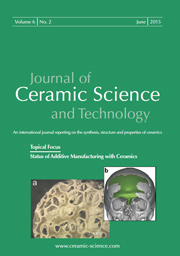Articles
All articles | Recent articles
Instrumented Compaction Experiments under Varied Climatic Conditions
Ulrich Klemm1, Bettina Schöne1, Hermann Svoboda1, Manfred Fries2, Manfred Nebelung2
1 Technische Universität Dresden, Institute of Material Science, D-01062 Dresden
2 Fraunhofer IKTS Dresden, Winterbergstrasse 28, D-01277 Dresden, Germany
received April 29, 2010, received in revised form June 14, 2010, accepted July 26, 2010
Vol. 1, No. 1, Pages 59-66 DOI: 10.4416/JCST2010-00016
Abstract
From empirical observations in industrial practice it is known that compaction behaviour and quality of uniaxial pressed ceramic compacts may be significantly influenced by climatic conditions during granulate storage and processing. At the same time, the type of basic material, added binders and lubricants can play a major role in most cases. In the present study, an attempt was made to reach a better understanding of the interactions between climatic conditions and compaction behaviour of silicon nitride granulates with different binder/lubricant systems by using instrumented compaction experiments. In addition to the continuous measurement of the pressure-density development and the strength of the compacts, parameters are measured which characterize the friction conditions, the total compaction energy and their single parts, the elastic redeformation in axial and radial directions. From the calculation of shear and compressive stresses, conclusions can be drawn regarding acting failure mechanisms and predictions of the expected density distribution can be given. For the examined silicon nitride granulates a deleterious influence of moisture on the whole pressing process and the defect rate of the compacts after storage of granulates at a humidity of more than 50 % before compaction was verified. For this material the changes in compaction behaviour are not reversible after storage at lower humidity.
![]() Download Full Article (PDF)
Download Full Article (PDF)
Keywords
Instrumented compaction, friction, silicon nitride, granulate, climatic conditions
References
1 Lannutti, J.J., Characterization and control of compact microstructure, MRS Bulletin 22, 12, 38-44, (1997).
2 Schulle, W., Requirements for Ceramic Press Granulates and Evaluation by Measurement (in German), cfi 73, 2, 81-86, (1996).
3 Shinohara, N., Okumiya, M., Hotta, T., Nakahira, K., Naito, M., Uematsu, K., Effect of seasons on density, strength of alumina, Am. Ceram. Soc. Bull. 78, 2, 81-84, (1999).
4 Klemm, U., Sobek, D., Influence of admixing of lubricants on compressibility and compactibility of uranium dioxide powders, Powder Technology 57, 135-142, (1989).
5 Klemm, U., Sobek, D., Schöne, B., Vieth, S., Linke, D., 3.4.3.4: Instrumented Compaction and Green Body Characteristics (in German), in: Kriegesmann, J. (Editor): Technical Ceramic Materials (in German), Verlag Deutscher Wirtschaftsdienst Köln, Cologne, (2002).
6 Thompson, R. A., Mechanics of powder pressing: Model for powder densification, Am. Ceram. Soc. Bull. 60, 237-241, (1981).
7 Sobek, D., Himpel, G., Klemm, U., Rabe, T., Procedure to Determine the 3D Density Distribution in Bodies for Pressing (in German), Keramische Zeitschrift 53, 3, 198-201, (2001).
8 Whitman, D.W., Cumbers, D. I., Wu, X.K., Humidity sensitivity of dry-press binders, Am. Ceram. Soc. Bull. 74, 8, 76-79, (1995).
9 Vieth, D., Uhlmann, M., Linke, D., Klemm, U., Sobek, D., Börner, F.-D., Effect of surface silanisation on the dry pressing behavior of silicon nitride powder, J. Europ. Ceram. Soc. 23, 1997-2004, (2003).
Copyright
© 2010 Göller Verlag
Acknowledgments
The financial support from Sächsisches Staatsministerium für Wissenschaft und Kunst is gratefully acknowledged by the authors.


